A Novel BoHV-1-Vectored Subunit RVFV Vaccine Induces a Robust Humoral and Cell-Mediated Immune Response Against Rift Valley Fever in Sheep
Abstract
1. Introduction
2. Materials and Methods
2.1. Cells and Medium
2.2. Viruses
2.3. Antibodies
2.4. Construction of BoHV-1qmv Vector Virus Expressing the Chimeric RVFV Gn-GMCSF (Ovine) Fusion and Gc Proteins
2.5. Growth Kinetics and Plaque Size Assay
2.6. Characterization of RVFV Gn and Gc Proteins
2.7. Animal Experiment
2.8. Clinical Examination, Sample Collection, and Processing
2.9. Serum Virus Neutralization Assay for BoHV-1qmv- and BoHV-1qmv Sub-RVFV-Group Sheep Against RVFV Vaccine Strain MP-12 and BoHV-1 by Plaque Reduction
2.10. DNA Isolation and Quantitative PCR (qPCR)
2.11. RVFV-Specific Cell-Mediated Immune Response Assay
2.12. Statistical Analysis
3. Results
3.1. The Recombinant BoHV-1qmv Sub-RVFV-O Vaccine Virus Expresses the Chimeric RVFV Gn-GMCSF-FLAG and Gc-V5 Self-Cleavable Polyproteins
3.2. Like the BoHV-1 wt, the BoHV-1qmv Sub-RVFV Vaccine Virus Replicated with a Similar Kinetics and Virus Yield in MDBK Cells but Produced Smaller Plaques
3.3. The BoHV-1qmv Sub-RVFV-O Vaccine Virus Is Highly Attenuated and Safe in Immunized Sheep
3.4. Nasal Virus Shedding Following Primary and Booster Immunization
3.5. BoHV-1-Vector-Specific and RVFV-Specific SN Antibody Titers in Sheep in Response to Primary (BoHV-1qmv and BoHV-1qmv Sub-RVFV) and Booster (BoHV-1qmv Sub-RVFV) Vaccinations
3.6. RVFV-Specific Cell-Mediated Immune Response (CMI) in the BoHV-1qmv Sub-RVFV-Immunized Sheep
4. Discussion
5. Conclusions
Supplementary Materials
Author Contributions
Funding
Institutional Review Board Statement
Informed Consent Statement
Data Availability Statement
Acknowledgments
Conflicts of Interest
References
- Hartman, A.L.; Powell, D.S.; Bethel, L.M.; Caroline, A.L.; Schmid, R.J.; Oury, T.; Reed, D.S. Aerosolized Rift Valley fever virus causes fatal encephalitis in African green monkeys and common marmosets. J. Virol. 2014, 88, 2235–2245. [Google Scholar] [CrossRef] [PubMed]
- LaBeaud, A.D.; Ochiai, Y.; Peters, C.J.; Muchiri, E.M.; King, C.H. Spectrum of Rift Valley fever virus transmission in Kenya: Insights from three distinct regions. Am. J. Trop. Med. Hyg. 2007, 76, 795–800. Available online: https://www.ncbi.nlm.nih.gov/pubmed/17488893 (accessed on 28 February 2021). [CrossRef] [PubMed]
- Bird, B.H.; Nichol, S.T. Breaking the chain: Rift Valley fever virus control via livestock vaccination. Curr. Opin. Virol. 2012, 2, 315–323. [Google Scholar] [CrossRef] [PubMed]
- Ikegami, T.; Makino, S. The pathogenesis of Rift Valley fever. Viruses 2011, 3, 493–519. [Google Scholar] [CrossRef]
- Arthur, R.R.; el-Sharkawy, M.S.; Cope, S.E.; Botros, B.A.; Oun, S.; Morrill, J.C.; Shope, R.E.; Hibbs, R.G.; Darwish, M.A.; Imam, I.Z. Recurrence of Rift Valley fever in Egypt. Lancet 1993, 342, 1149–1150. [Google Scholar] [CrossRef] [PubMed]
- Balkhy, H.H.; Memish, Z.A. Rift Valley fever: An uninvited zoonosis in the Arabian peninsula. Int. J. Antimicrob. Agents 2003, 21, 153–157. [Google Scholar] [CrossRef]
- Shoemaker, T.; Boulianne, C.; Vincent, M.J.; Pezzanite, L.; Al-Qahtani, M.M.; Al-Mazrou, Y.; Khan, A.S.; Rollin, P.E.; Swanepoel, R.; Ksiazek, T.G.; et al. Genetic analysis of viruses associated with emergence of Rift Valley fever in Saudi Arabia and Yemen, 2000–2001. Emerg. Infect. Dis. 2002, 8, 1415–1420. [Google Scholar] [CrossRef]
- Anyangu, A.S.; Gould, L.H.; Sharif, S.K.; Nguku, P.M.; Omolo, J.O.; Mutonga, D.; Rao, C.Y.; Lederman, E.R.; Schnabel, D.; Paweska, J.T. Risk factors for severe Rift Valley fever infection in Kenya, 2007. Am. J. Trop. Med. Hyg. 2010, 83 (Suppl. 2), 14–21. [Google Scholar] [CrossRef]
- Gerrard, S.R.; Nichol, S.T. Synthesis, proteolytic processing and complex formation of N-terminally nested precursor proteins of the Rift Valley fever virus glycoproteins. Virology 2007, 357, 124–133. [Google Scholar] [CrossRef] [PubMed]
- Faburay, B.; LaBeaud, A.D.; McVey, D.S.; Wilson, W.C.; Richt, J.A. Current Status of Rift Valley Fever Vaccine Development. Vaccines 2017, 5, 29. [Google Scholar] [CrossRef]
- Harmon, J.R.; Barbeau, D.J.; Nichol, S.T.; Spiropoulou, C.F.; McElroy, A.K. Rift Valley fever virus vaccination induces long-lived, antigen-specific human T cell responses. NPJ Vaccines 2020, 5, 17. [Google Scholar] [CrossRef]
- Caplen, H.; Peters, C.J.; Bishop, D.H. Mutagen-Directed attenuation of Rift Valley fever virus as a method for vaccine development. J. Gen. Virol. 1985, 66 Pt 10, 2271–2277. [Google Scholar] [CrossRef]
- Saluzzo, J.F.; Smith, J.F. Use of reassortant viruses to map attenuating and temperature-sensitive mutations of the Rift Valley fever virus MP-12 vaccine. Vaccine 1990, 8, 369–375. [Google Scholar] [CrossRef] [PubMed]
- Vialat, P.; Muller, R.; Vu, T.H.; Prehaud, C.; Bouloy, M. Mapping of the mutations present in the genome of the Rift Valley fever virus attenuated MP12 strain and their putative role in attenuation. Virus Res. 1997, 52, 43–50. [Google Scholar] [CrossRef] [PubMed]
- Grobbelaar, A.A.; Weyer, J.; Leman, P.A.; Kemp, A.; Paweska, J.T.; Swanepoel, R. Molecular epidemiology of Rift Valley fever virus. Emerg. Infect. Dis. 2011, 17, 2270–2276. [Google Scholar] [CrossRef] [PubMed]
- Ly, H.J.; Lokugamage, N.; Nishiyama, S.; Ikegami, T. Risk analysis of inter-species reassortment through a Rift Valley fever phlebovirus MP-12 vaccine strain. PLoS ONE 2017, 12, e0185194. [Google Scholar] [CrossRef] [PubMed]
- Mazloum, A.; Van Schalkwyk, A.; Babiuk, S.; Venter, E.; Wallace, D.B.; Sprygin, A. Lumpy skin disease: History, current understanding and research gaps in the context of recent geographic expansion. Front. Microbiol. 2023, 14, 1266759. [Google Scholar] [CrossRef] [PubMed]
- Kitandwe, P.K.; McKay, P.F.; Kaleebu, P.; Shattock, R.J. An Overview of Rift Valley Fever Vaccine Development Strategies. Vaccines 2022, 10, 1794. [Google Scholar] [CrossRef]
- Wallace, D.B.; Mather, A.; Kara, P.D.; Naicker, L.; Mokoena, N.B.; Pretorius, A.; Nefefe, T.; Thema, N.; Babiuk, S. Protection of Cattle Elicited Using a Bivalent Lumpy Skin Disease Virus-Vectored Recombinant Rift Valley Fever Vaccine. Front. Vet. Sci. 2020, 7, 256. [Google Scholar] [CrossRef]
- Faburay, B.; Lebedev, M.; McVey, D.S.; Wilson, W.; Morozov, I.; Young, A.; Richt, J.A. A glycoprotein subunit vaccine elicits a strong Rift Valley fever virus-neutralizing antibody response in sheep. Vector Borne Zoonotic Dis. 2014, 14, 746–756. [Google Scholar] [CrossRef]
- Pavulraj, S.; Stout, R.W.; Paulsen, D.B.; Chowdhury, S.I. A Quadruple Gene-Deleted Live BoHV-1 Subunit RVFV Vaccine Vector Reactivates from Latency and Replicates in the TG Neurons of Calves but Is Not Transported to and Shed from Nasal Mucosa. Viruses 2024, 16, 1497. [Google Scholar] [CrossRef] [PubMed]
- Pavulraj, S.; Stout, R.W.; Barras, E.D.; Paulsen, D.B.; Chowdhury, S.I. A Novel Quadruple Gene-Deleted BoHV-1-Vectored RVFV Subunit Vaccine Induces Humoral and Cell-Mediated Immune Response against Rift Valley Fever in Calves. Viruses 2023, 15, 2183. [Google Scholar] [CrossRef] [PubMed]
- Chowdhury, S.I.; Pannhorst, K.; Sangewar, N.; Pavulraj, S.; Wen, X.; Stout, R.W.; Mwangi, W.; Paulsen, D.B. BoHV-1-Vectored BVDV-2 Subunit Vaccine Induces BVDV Cross-Reactive Cellular Immune Responses and Protects against BVDV-2 Challenge. Vaccines 2021, 9, 46. [Google Scholar] [CrossRef] [PubMed]
- Nansikombi, H.T.; Zalwango, J.F.; Ndyabakira, A.; Kwesiga, B.; Bulage, L.; Ario, A.R.; Harris, J.R.; Kyamwine, I.B.; Tumusiime, D.; Monje, F. The importance of a One Health approach in preventing human Rift Valley fever infections in Uganda. IJID One Health 2024, 4, 100034. [Google Scholar] [CrossRef]
- Watts, D.M.; Westover, J.L.B.; Palermo, P.M.; Bailey, K.W.; Morrill, J.C.; Bettinger, G.E.; Monath, T.P.; Smith, D.R.; Peters, C.J.; Pittman, P.R.; et al. Estimation of the Minimal Rift Valley Fever Virus Protective Neutralizing Antibody Titer in Human Volunteers Immunized with MP-12 Vaccine Based on Protection in a Mouse Model of Disease. Am. J. Trop. Med. Hyg. 2022, 107, 1091–1098. [Google Scholar] [CrossRef]
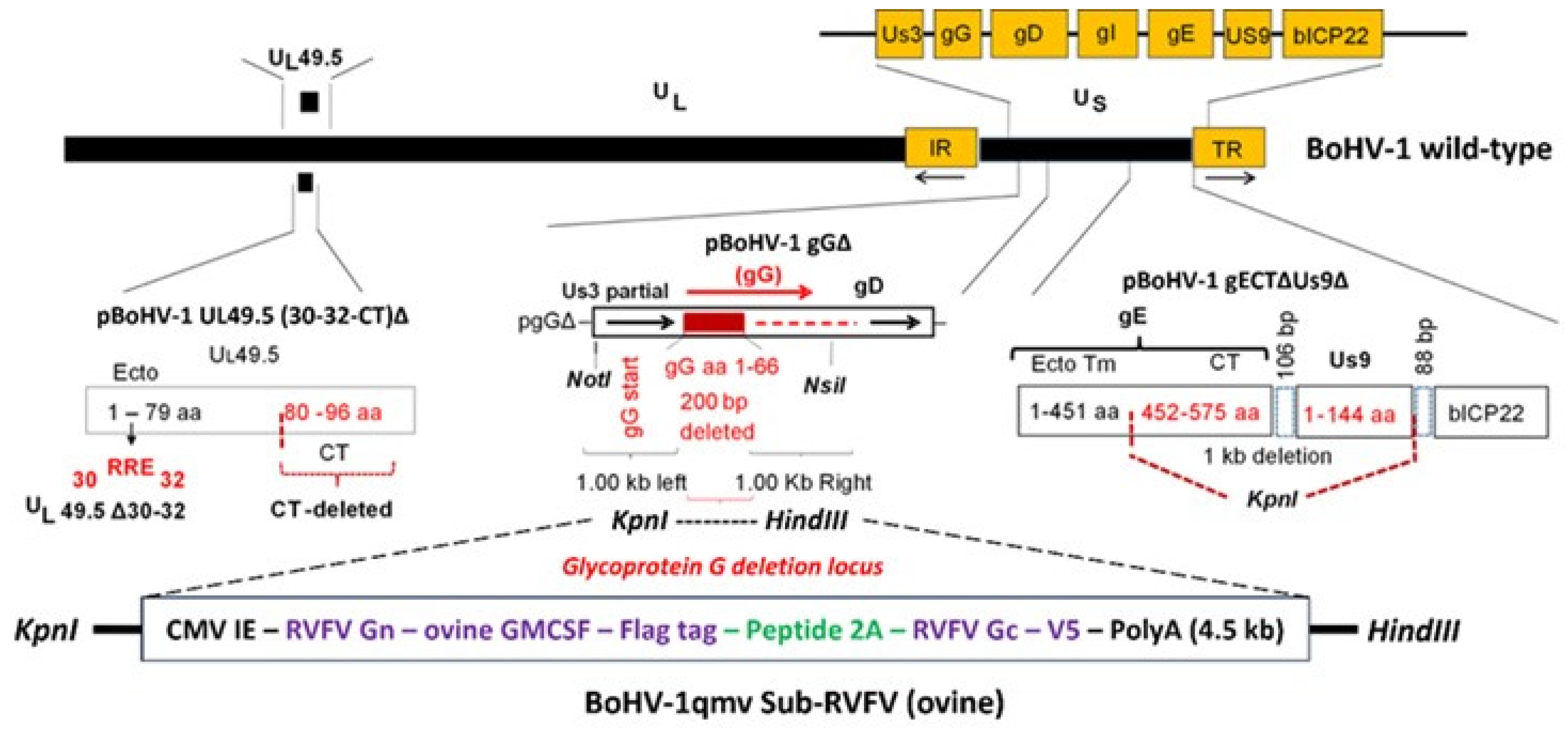
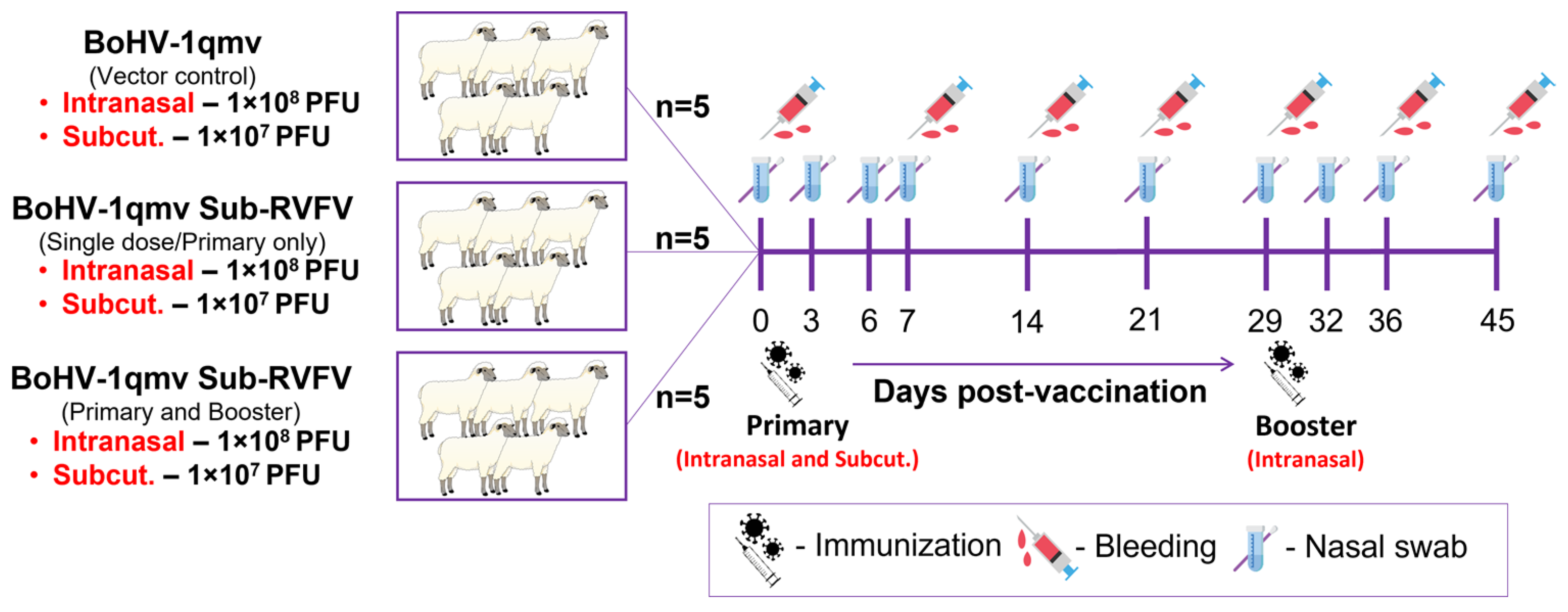
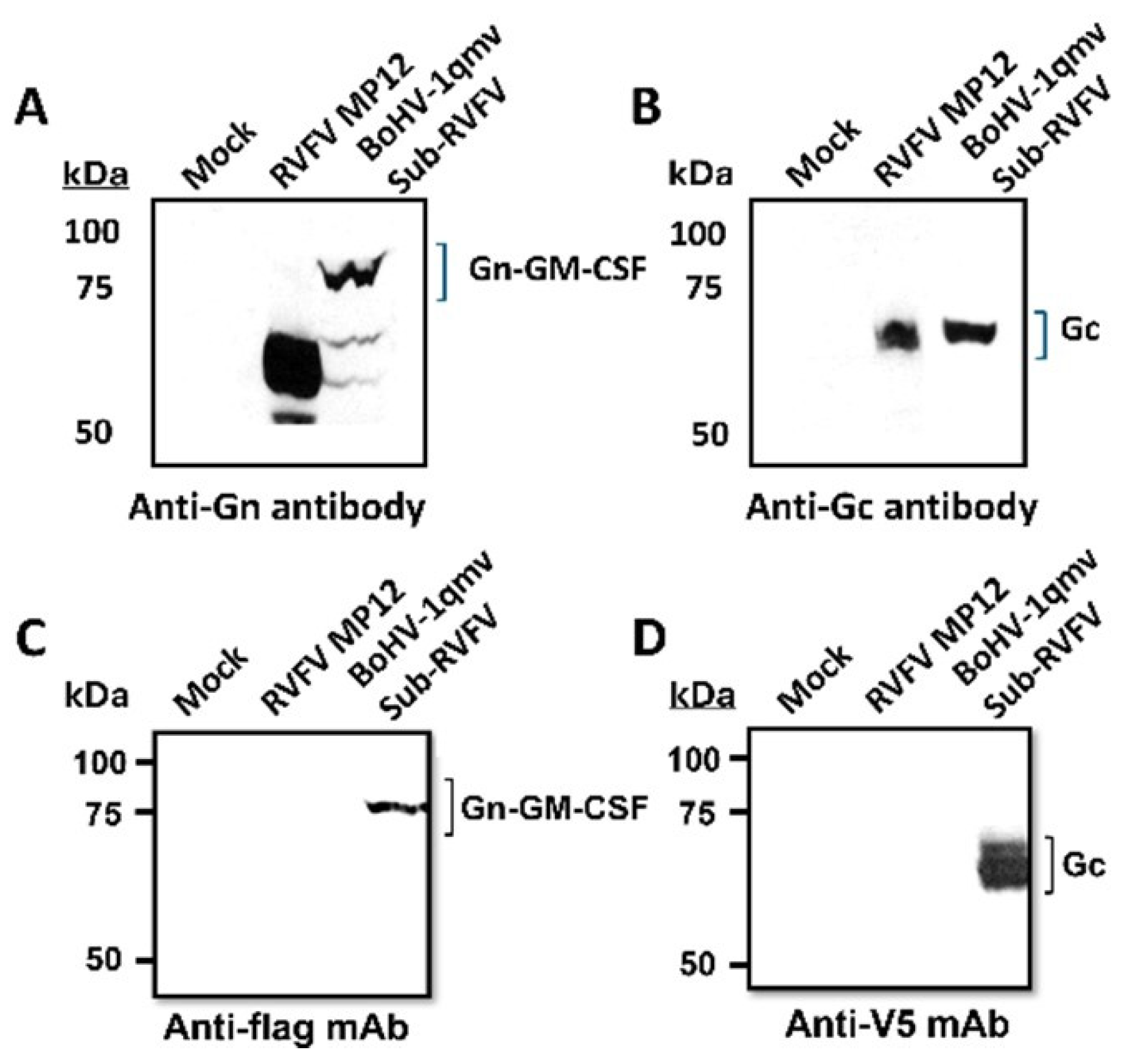
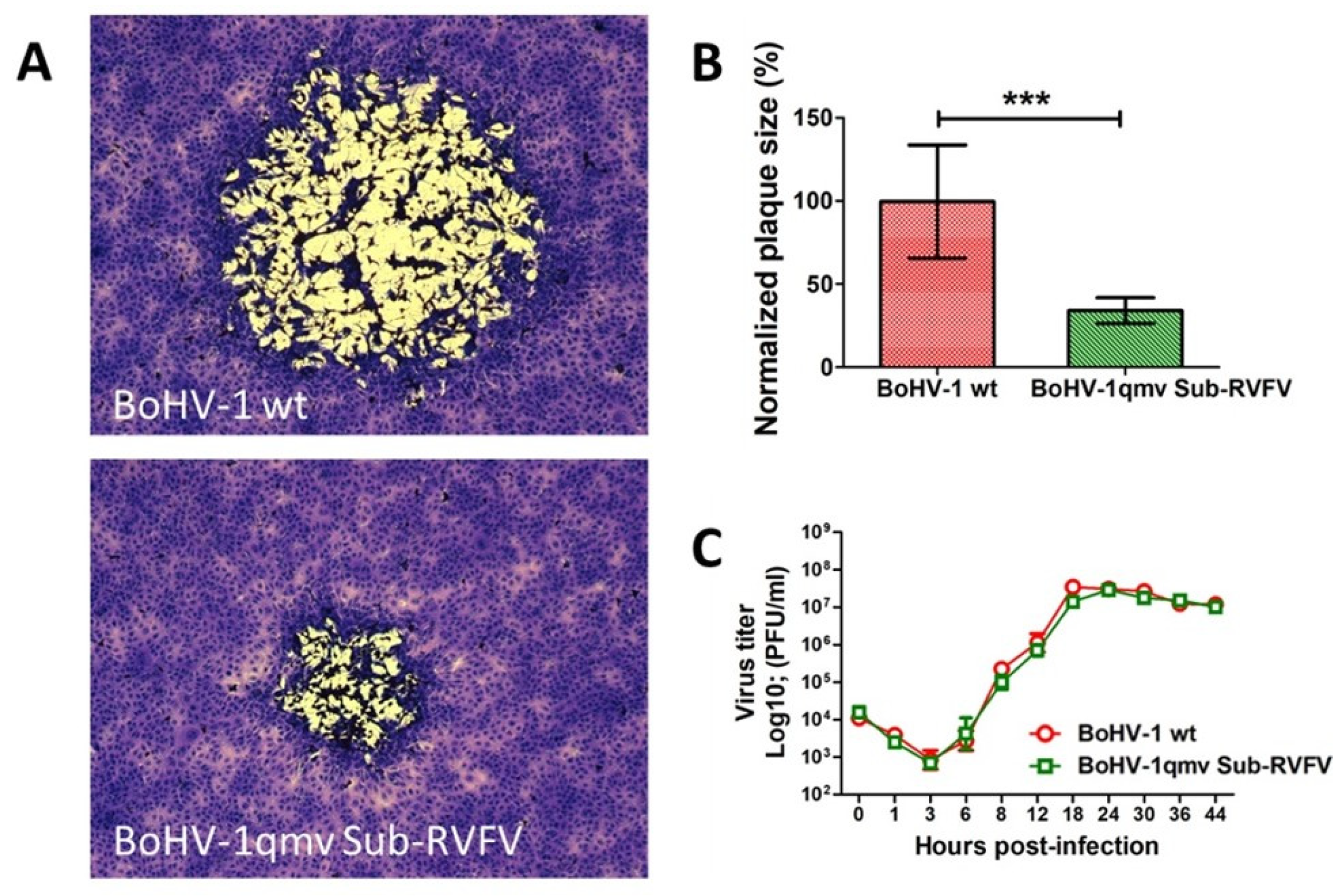
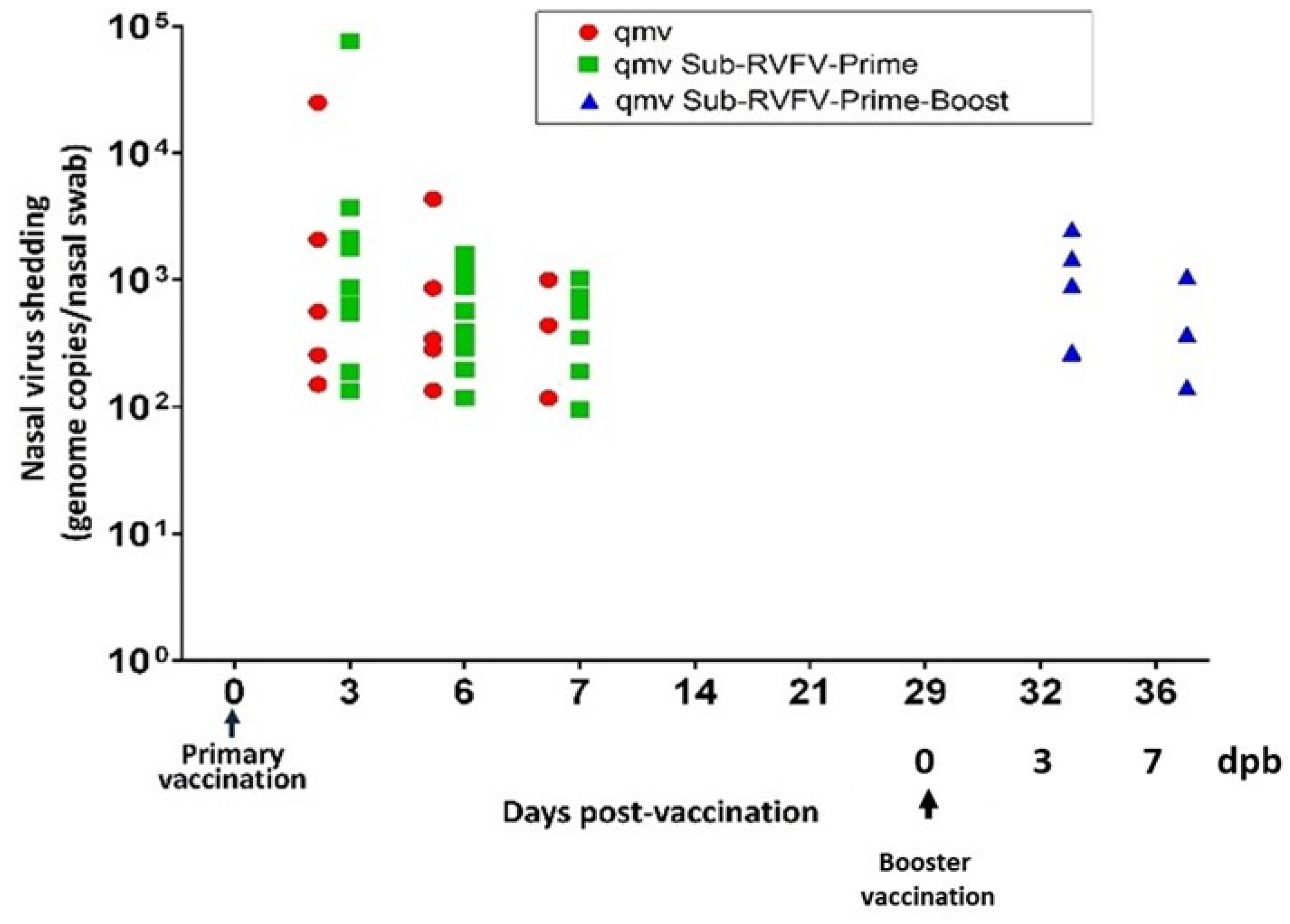
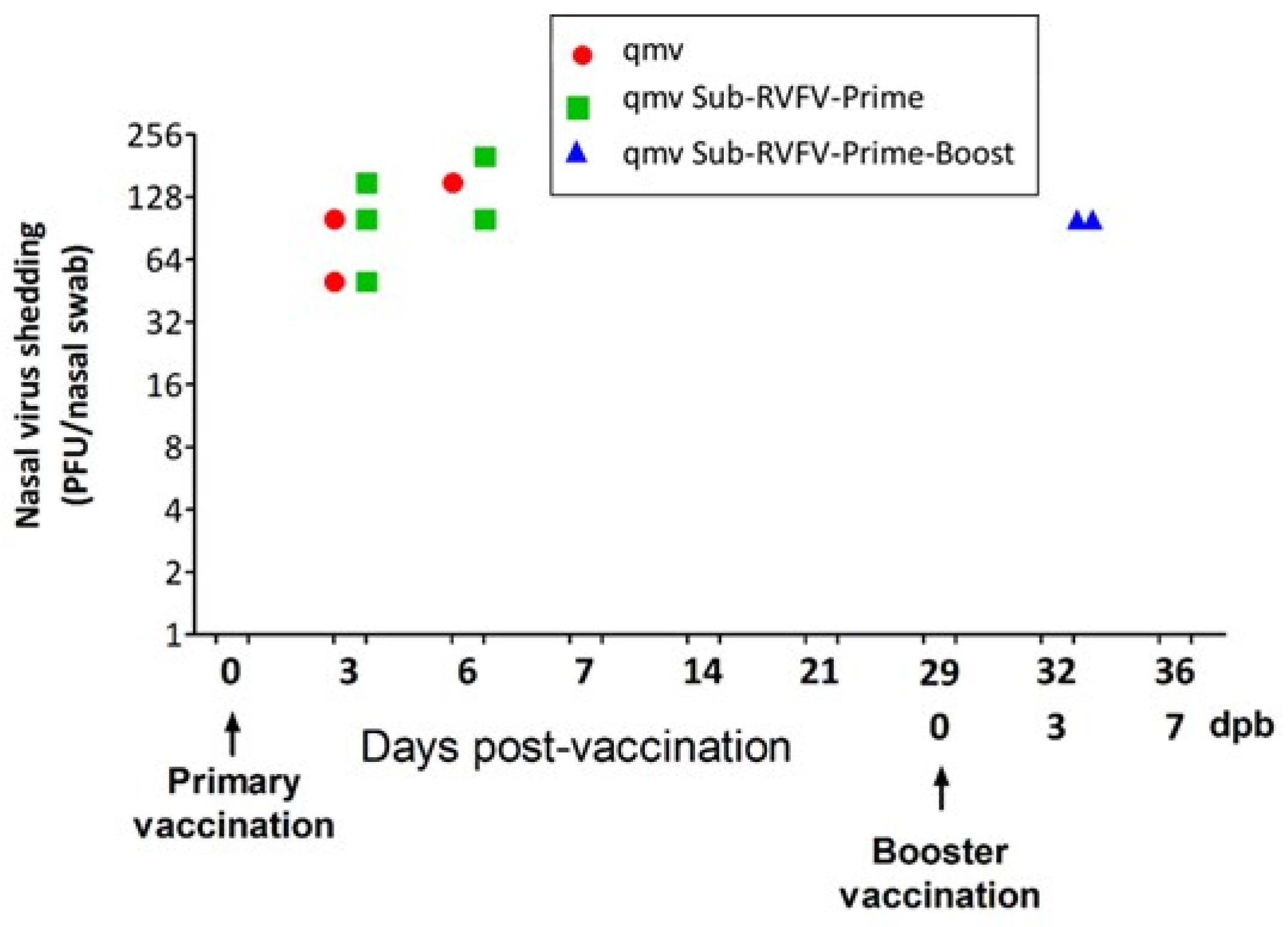

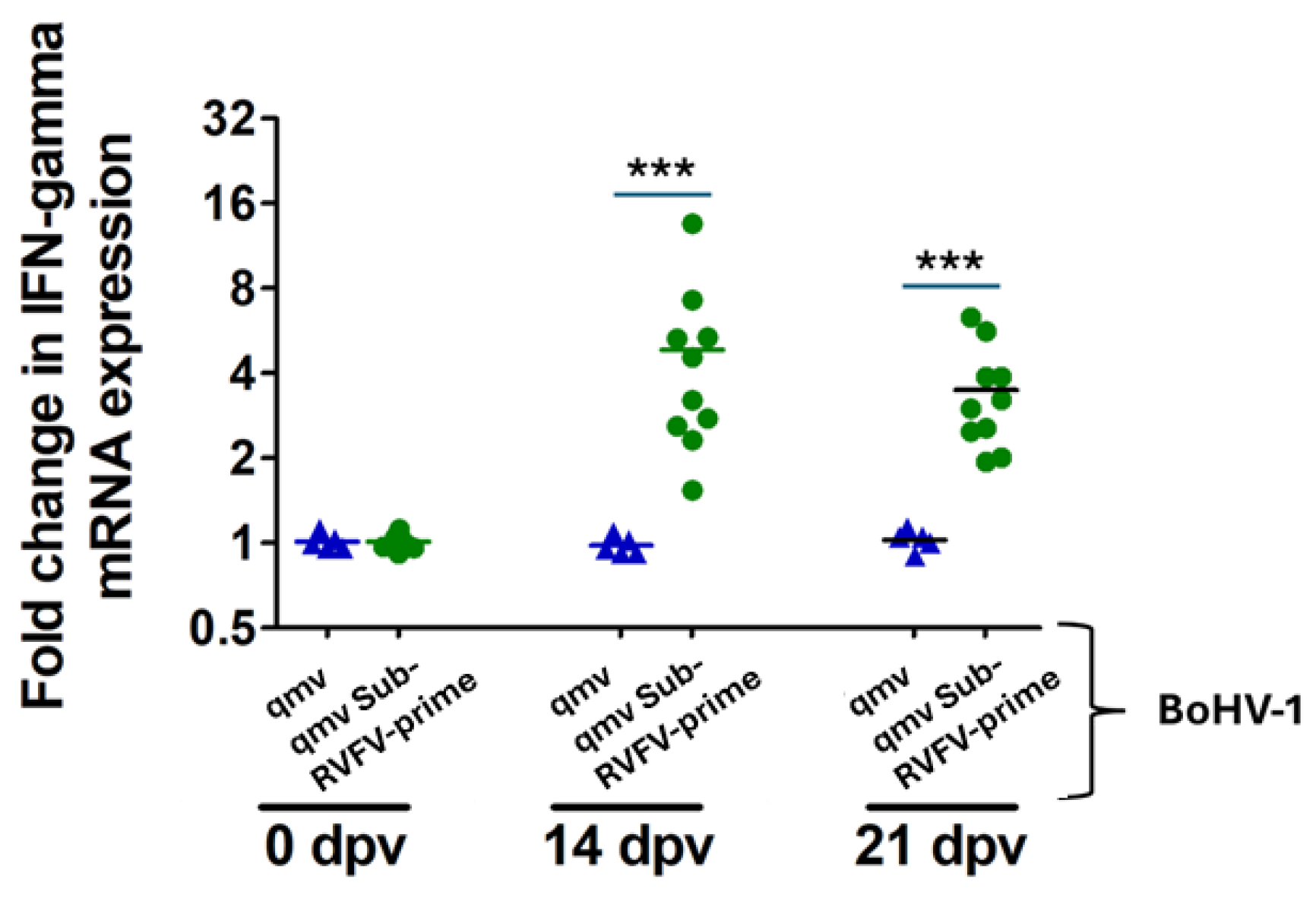
Disclaimer/Publisher’s Note: The statements, opinions and data contained in all publications are solely those of the individual author(s) and contributor(s) and not of MDPI and/or the editor(s). MDPI and/or the editor(s) disclaim responsibility for any injury to people or property resulting from any ideas, methods, instructions or products referred to in the content. |
© 2025 by the authors. Licensee MDPI, Basel, Switzerland. This article is an open access article distributed under the terms and conditions of the Creative Commons Attribution (CC BY) license (https://creativecommons.org/licenses/by/4.0/).
Share and Cite
Pavulraj, S.; Stout, R.W.; Chowdhury, S.I. A Novel BoHV-1-Vectored Subunit RVFV Vaccine Induces a Robust Humoral and Cell-Mediated Immune Response Against Rift Valley Fever in Sheep. Viruses 2025, 17, 304. https://doi.org/10.3390/v17030304
Pavulraj S, Stout RW, Chowdhury SI. A Novel BoHV-1-Vectored Subunit RVFV Vaccine Induces a Robust Humoral and Cell-Mediated Immune Response Against Rift Valley Fever in Sheep. Viruses. 2025; 17(3):304. https://doi.org/10.3390/v17030304
Chicago/Turabian StylePavulraj, Selvaraj, Rhett W. Stout, and Shafiqul I. Chowdhury. 2025. "A Novel BoHV-1-Vectored Subunit RVFV Vaccine Induces a Robust Humoral and Cell-Mediated Immune Response Against Rift Valley Fever in Sheep" Viruses 17, no. 3: 304. https://doi.org/10.3390/v17030304
APA StylePavulraj, S., Stout, R. W., & Chowdhury, S. I. (2025). A Novel BoHV-1-Vectored Subunit RVFV Vaccine Induces a Robust Humoral and Cell-Mediated Immune Response Against Rift Valley Fever in Sheep. Viruses, 17(3), 304. https://doi.org/10.3390/v17030304






